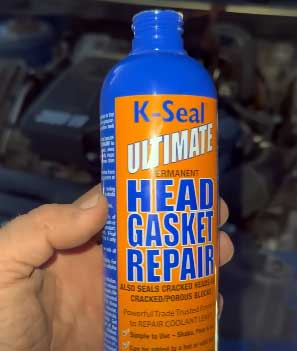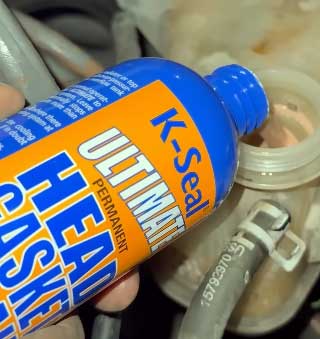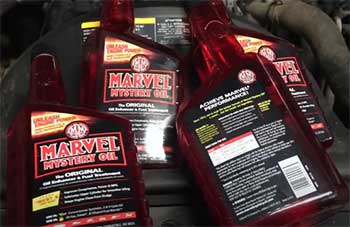I’ve been there—staring under the hood, watching coolant drip onto the driveway, and wondering how to fix it without breaking the bank. That’s why I’m tackling the K-Seal vs. Bar’s Leak debate, two heavyweights in the radiator stop-leak world.
My goal?
To break down their features, weigh the pros and cons, and help you decide which one deserves a spot in your toolbox. With a conversational vibe and real-world insights, let’s figure out which product can save your engine from a costly meltdown.
A Brief Comparison Table
| Feature | K-Seal | Bar’s Leak |
| Primary Use | Radiator, head gasket, block leaks | Radiator, heater core, minor leaks |
| Formula Type | Ceramic microfibers | Sodium silicate + fibers |
| Application Ease | Shake, pour, drive | Shake, pour, idle for 15-30 min |
| Cure Time | Near-instant (with heat) | 15-30 minutes |
| Permanent Fix Claim | Yes | Yes, for minor leaks |
| Compatibility | All antifreeze types | Most antifreeze types |
| Price (approx.) | $15-$25 | $5-$15 |
| Volume (typical) | 8 oz or 16 oz | 10-11.5 oz |
| Best For | Severe leaks, head gaskets | Budget fixes, small leaks |
My Journey With Radiator Leaks
A few years back, my old sedan started leaving green puddles everywhere. I wasn’t ready to shell out hundreds for a mechanic, so I turned to stop-leak products. K-Seal and Bar’s Leak kept popping up in forums, auto shops, and YouTube videos.
I’ve used both, tested them on different vehicles, and talked to mechanics to get the full scoop. This article is my way of sharing that experience, so you can make an informed choice without the trial-and-error I went through.
What Are K-Seal and Bar’s Leak?

K-Seal and Bar’s Leak are liquid sealants designed to plug leaks in your cooling system—think radiators, heater cores, and even head gaskets.
They’re like Band-Aids for your engine, offering a quick fix when you’re in a pinch.
Both work by circulating through the coolant, finding leaks, and hardening to form a seal. But their formulas and strengths differ, which is where the real comparison kicks in.
K-Seal uses ceramic microfibers to create a tough, heat-resistant seal.
It’s marketed as a permanent fix, especially for nasty leaks like blown head gaskets. Bar’s Leak, on the other hand, relies on sodium silicate (liquid glass) mixed with fibers.
It’s been around forever and is known for tackling smaller leaks on a budget. Let’s break down what makes each one tick.
K-Seal: The Heavy-Duty Contender
Key Features of K-Seal
K-Seal’s formula feels like something out of a sci-fi movie. Those ceramic particles are tiny but mighty, bonding to metal and plastic under heat and pressure. Here’s what stands out:
- Universal compatibility: Works with all antifreeze types, so you don’t need to flush your system first.
- Multi-leak coverage: Fixes radiators, head gaskets, heater cores, and engine blocks.
- Fast-acting: Seals leaks almost instantly once the engine heats up.
- Permanent claim: Marketed as a long-term solution, not just a temporary patch.
- Easy application: Shake the bottle, pour it into the radiator or overflow tank, and drive.
I first tried K-Seal on a friend’s truck with a head gasket leak. White smoke was billowing from the exhaust, and the coolant was disappearing fast. We poured in a bottle of K-Seal Ultimate, ran the engine for 20 minutes, and the smoke stopped. It held up for over a year before he sold the truck. That’s when I became a believer.
Pros of K-Seal

- Tackles severe leaks: Head gasket fixes are no joke, and K-Seal handles them better than most.
- Quick results: You’re back on the road in minutes, not hours.
- No flushing required: Saves time and hassle compared to some competitors.
- Durable seal: The ceramic bond is tough, resisting high temperatures and pressure.
- Trusted brand: Backed by positive reviews from DIYers and mechanics alike.
Cons of K-Seal
- Pricey: At $15-$25 per bottle, it’s not the cheapest fix out there.
- Limited volume: An 8 oz bottle might not suffice for larger systems, forcing you to buy more.
- Not foolproof: Some users report leaks returning after months, especially on older vehicles.
- Clogging risk: If overused, it can gunk up heater cores or narrow passages.
- Specific application: Needs a warm engine to work best, so cold-weather fixes can be tricky.
I learned the clogging lesson the hard way. On my second K-Seal attempt, I poured too much into a small car’s radiator, and the heater stopped blowing warm air. A flush fixed it, but it was a headache I could’ve avoided by following the dosage instructions.
Bar’s Leak: The Budget-Friendly Veteran
Key Features of Bar’s Leak
Bar’s Leak has been saving drivers’ wallets since the 1940s. Its sodium silicate formula hardens like glass when exposed to air at the leak site, reinforced by fibers for extra strength. Here’s what you get:

- Affordable: Often under $10 for a standard bottle.
- Wide availability: Found in every auto parts store and big-box retailer.
- Simple use: Pour it in, idle for 15-30 minutes, and check for leaks.
- Versatile: Works on radiators, heater cores, and minor head gasket leaks.
- Multiple products: Offers specialized formulas like Head Gasket Fix for tougher jobs.
I used Bar’s Leak Liquid Radiator Stop Leak on my wife’s minivan when the radiator started weeping. It was a small leak, but enough to annoy me. After idling for 30 minutes, the drip was gone, and it stayed that way for six months until we replaced the radiator.
Pros of Bar’s Leak
- Cheap: Perfect for those “I need a fix now” moments without spending much.
- Proven track record: Decades of use mean it’s reliable for minor leaks.
- Easy to find: No hunting required; it’s everywhere.
- Multiple options: From basic stop-leak to heavy-duty head gasket formulas.
- Low risk: Less likely to clog systems if used as directed.
Cons of Bar’s Leak
- Slower acting: Requires idling or driving for 15-30 minutes to set.
- Limited for big leaks: Struggles with severe head gasket or block issues.
- Temporary for some: Larger leaks may return sooner than with K-Seal.
- Antifreeze sensitivity: Some formulas don’t play well with certain coolants.
- Messy residue: Can leave silicate deposits in the system, requiring a flush later.
One downside hit me when I tried Bar’s Leak on an older SUV with a cracked block. It slowed the leak but didn’t stop it. For smaller jobs, though, it’s hard to beat the price.
How K-Seal And Bar’s Leak Stack Up?
- Effectiveness
K-Seal takes the crown for serious leaks. Its ceramic formula is engineered for high-pressure, high-heat environments like head gaskets. I’ve seen it stop leaks that mechanics swore needed a $2,000 repair.
Bar’s Leak shines for minor radiator and heater core leaks, but it’s less reliable for major issues. If your engine’s blowing steam like a kettle, K-Seal’s your better bet.

- Ease of Use: Both are simple, but K-Seal edges out slightly. You pour it in, drive, and you’re done. Bar’s Leak requires idling for up to 30 minutes, which feels like forever when you’re stressed about a leak. I prefer K-Seal’s “set it and forget it” vibe, especially on busy days.
- Cost: Bar’s Leak wins hands-down. At half the price of K-Seal, it’s a no-brainer for budget-conscious drivers. But you get what you pay for—K-Seal’s higher cost reflects its advanced formula and broader leak coverage. If you’re fixing a beater car, Bar’s Leak is fine; for a daily driver, K-Seal’s worth the splurge.
- Longevity: K-Seal claims a permanent fix, and in my experience, it holds up longer—sometimes years. Bar’s Leak also claims permanence for minor leaks, but I’ve noticed leaks creeping back after months on bigger jobs. For long-term peace of mind, K-Seal’s ceramic seal feels more robust.
- Compatibility: K-Seal’s universal formula works with any antifreeze, making it a safer choice for mixed systems. Bar’s Leak is compatible with most coolants, but some users report issues with certain brands. I’ve never had a compatibility problem with K-Seal, which gives it a slight edge.
Real-World Scenarios: Which One To Choose?
Let’s paint some pictures to help you decide.
- Scenario 1: The Daily Driver Disaster
Your commute car’s radiator is leaking, and you need a quick fix before a road trip. Bar’s Leak is ideal here. It’s cheap, easy to find, and perfect for small radiator leaks. Grab a bottle, idle for 30 minutes, and hit the road. - Scenario 2: The Head Gasket Nightmare
Your truck’s spewing white smoke, and the mechanic’s quoting thousands. K-Seal’s your go-to. Its ceramic formula is built for head gasket chaos. Pour it in, pray a little, and drive. It saved my buddy’s truck, and it might save yours. - Scenario 3: The Beater Car Band-Aid
Your $500 clunker’s leaking coolant, but you just need it to last another month. Bar’s Leak’s low price makes it a no-risk choice. If it fails, you’re not out much, and it’ll likely hold long enough. - Scenario 4: The Vintage Ride Rescue
Your classic car’s heater core is dripping, and parts are hard to find. K-Seal’s fast-acting formula is better for older systems, where clogs are a bigger concern. It’s pricier, but your baby’s worth it.
Tips For Using Stop-Leak Products
From my mishaps and successes, here’s how to get the most out of K-Seal or Bar’s Leak:
- Follow the dosage: Too much can clog your system, like my heater core fiasco.
- Warm up the engine: Both work better with heat, especially K-Seal.
- Check compatibility: Double-check your antifreeze type, especially with Bar’s Leak.
- Monitor after application: Keep an eye on coolant levels for a few days.
- Flush later: If you plan to keep the car long-term, flush the system after a few months to avoid buildup.
The Bigger Picture: Are Stop-Leaks a Real Fix?
Stop-leak products are lifesavers, but they’re not magic. They’re best for buying time or avoiding costly repairs on cars that aren’t worth fixing. For a new vehicle or a critical repair, see a mechanic.
I’ve used both K-Seal and Bar’s Leak to delay radiator replacements, but eventually, I had to bite the bullet. Think of them as triage, not surgery.
Also Read: Is Bar’s Leaks Power Steering Repair Worth It?
Frequently Asked Questions (FAQ)
For head gasket and severe leaks, K-Seal’s ceramic formula is top-tier. BlueDevil Head Gasket Sealer is a strong alternative but pricier and less versatile.
K-Seal Ultimate is best for major leaks like head gaskets, while Bar’s Leak Liquid Radiator Stop Leak excels for minor radiator fixes on a budget.
K-Seal claims a permanent fix, and I’ve seen it last years for head gasket leaks. But for aging systems, leaks may return eventually.
Yes, Bar’s Leak works well for small radiator and heater core leaks. For bigger issues, it’s less reliable but still worth a try for the price.
Conclusion: Your Leak, Your Choice
You’re standing in the auto parts aisle, staring at K-Seal and Bar’s Leak, wondering which one’s going to save your car. I’ve been there, and I hope my experience makes your decision easier. If you’re battling a monster leak like a blown head gasket, K-Seal’s ceramic muscle is your best shot.
If you need a cheap, quick fix for a dripping radiator, Bar’s Leak won’t let you down. Weigh your leak’s severity, your budget, and your car’s value, then pick the one that fits.
You’ve got this—go plug that leak and get back on the road.

